
While we’re well past the era of “reefer madness,” folks seem to still have plenty of misconceptions about cannabis. As an elderly patient, you may wonder about the developments in medicinal cannabis over the years. You might even consider trying it out. It turns out that not only can seniors benefit from medical marijuana, but they may also find it works better than standard medication.
Cannabis medicine can relieve a wide variety of symptoms and medical conditions, many of which elderly folks commonly deal with. Aging.com, a National Council for Aging Care, presented a study conducted in 2013 that found out of 7,500 medical marijuana, 90 percent stated the medicine helped their condition. More than 2,300 of these participants were seniors.
The most common conditions treated with marijuana medicine include:
When it comes to the senior population, Alzheimer’s is a main concern, as 5.7 million Americans suffer from the degenerative brain disease that impacts memory capabilities and brain functions. Some of the disease’s symptoms include loss of appetite and depression.
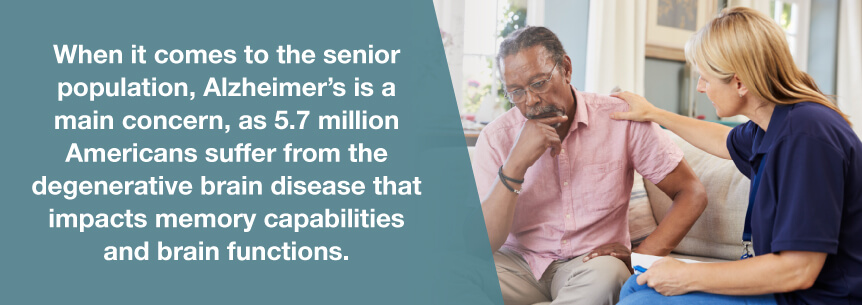
Medical cannabis can benefit seniors who have this disease by helping to increase appetite and reduce depression. While it may not heal the incurable disease, it reassures family members and assists the individual to cope with the illness in a less stressful manner.
Medical marijuana has also been shown to relieve other health issues, but the ones listed above have the most scientific and legal support. Not only do they have a lot of research backing their responsiveness to medical cannabis, but they also have the highest likelihood of authorization by state medical marijuana programs.
The scientific and anecdotal evidence we have suggests that cannabis works as a(n):
Whether you can legally use medical marijuana in your state depends on the health issues it authorizes for cannabis medicine treatment. Research your state medical marijuana laws to see if you could qualify.
Since marijuana has so much stigma surrounding it, many folks think using marijuana can severely harm their health. However, the side effects of marijuana tend to be relatively harmless and easy to control. Common medical marijuana side effects include:
Patients who deal with these side effects can often utilize an easy fix or switch their medication time to resolve them. For example, they can drink extra water to counteract their thirst, or they can take their medicine at a different time of day if it makes them feel sleepy.
One benefit of medical marijuana may be allowing seniors to skip prescription drugs. For example, among those suffering from chronic pain, many receive oxycodone prescriptions. This drug can have a slew of side effects that take a toll on seniors, such as:
Unlike cannabis, prescription drugs can have a lasting impact that can affect the human body in more extreme ways. These prescription drugs, such as opioids, due to their addictive natures, cause a person’s body to build up tolerance levels, making the medication less effective and causing a person to consume a greater dosage to keep up with their pain level.
Researchers say cannabis has no impact on major psychological functions. Scientists have also found it is impossible to lethally overdose on cannabis. You would have to smoke almost two tons of weed in fifteen minutes, making cannabis a safe medication compared to other medical drugs that still run the risk of a possible overdose, even if they don’t have immediate, threatening conditions.
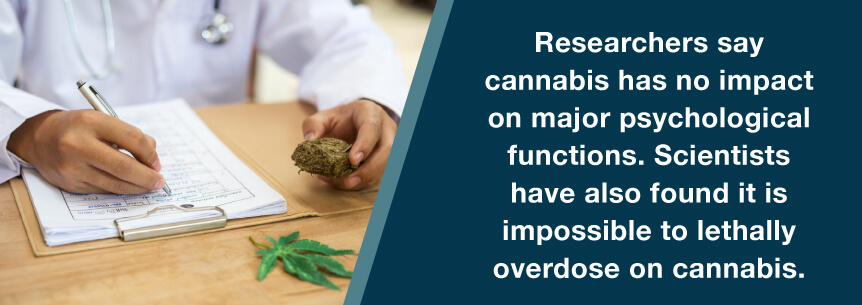
Cannabis is a natural medication that comes from uncut cannabis plants. It is a pure form of the plant. Cannabis, also known as a hemp plant, originated in Central Asia around 500 B.C. The ancient civilizations used this plant for many things, including:
They even employed it for food. These cultures also used it for herbal needs. It wasn’t till the late 1800s in Europe and the United States that the concept of a medical use for the plant took off. It began being sold in pharmacies to treat cholera by reducing stomach pain and vomiting.
While other cultures used marijuana for recreational purposes, hemp has always had multiple uses. Many of these civilizations smoked the plant in order to get the effects they desired, but that isn’t the only method for the intake of cannabis.
You may worry about hurting your lungs by smoking marijuana, and while smoking cannabis can indeed harm your lungs, you have many other options for how to take your medicine. The ways you can legally take medical marijuana depend on your state laws, but here are some examples that don’t involve smoking:
In some cases, patients discover they have a bad reaction to their marijuana medication, like paranoia. Don’t worry if this happens to you — you can work closely with your doctor to try a different kind of cannabis medicine that will have different effects.
Contrary to widespread belief, not every kind of cannabis medication makes you feel the “high” we commonly associate with marijuana. The versatility of marijuana medicine is all thanks to the science behind the plant.
Cannabis is made up of numerous compounds called cannabinoids. While we know about around 500 different cannabinoids, the two primary cannabinoids in marijuana are cannabidiol (CBD) and tetrahydrocannabinol (THC). These two compounds cause many of the medical benefits we get from cannabis.
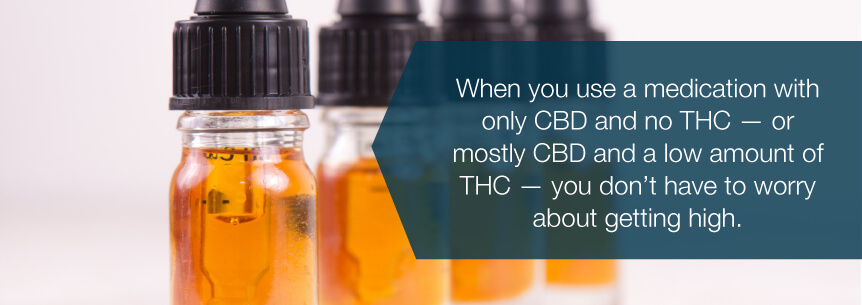
When you use a medication with only CBD and no THC — or mostly CBD and a low amount of THC — you don’t have to worry about getting high. CBD doesn’t impair your thinking, but it can still help with symptoms like pain and seizures. You may feel drowsy when you take CBD-based medicine, but you can still think and act the same.
CBD may actually counteract THC, in the sense that it does not give you the high feeling that is often associated with any use of weed, whether it be medical or recreational. CBD binds to receptors in your cells. By doing so, it helps regulate mood, sleep cycle, body temperature and inflammation.
CBD offers a growing potential for a medical drug, legal in some states that acknowledge its effectiveness. CBD is currently being tested for further research on its anti-cancer properties. These stem from its ability to have neuroprotective and neurogenic effects. CBD has proven to protect nerves from injury or harm, as well as combated illnesses that stem from the nervous system, such as chronic pain, inflammation and anxiety.
Medical marijuana isn’t considered a part of the typical drugs you find in the United States. Since you can’t find marijuana medicine at your local pharmacy, doesn’t that mean it isn’t as effective? Fortunately, medical marijuana can work just as well as — if not better than — standard medication.
Research on the effects of cannabis on elderly patients is being conducted worldwide, based on the growing need for and interest in medical marijuana to achieve the goal of putting it on pharmacy shelves.
For example, the Cannabis Clinical Research Institute at Soroka University Medical Center in Beersheba and the Ben-Gurion University of the Negev teamed up to study 2,736 patients treated with medical cannabis. Sixty percent of these patients were dealing with pain, most of it from symptoms of cancer. More than 93 percent of respondents said their pain levels had been reduced drastically following a six-month course of cannabis.
The United States federal government says it has not legalized medical marijuana because there is not enough research and widespread studies. However, its own policies hamper research opportunities. The government still doesn’t recognize medical marijuana as a medication, rather classifying it as a Schedule 1 drug. This limits researchers from conducting the types of thorough studies of cannabis needed in order to receive approval for medical usage by the FDA, despite the continuous positive feedback researchers are finding.
Medical marijuana for the elderly unquestionably provides many medical benefits. Here are the top ten reasons why cannabis is healthier to use for seniors versus a prescription drug:
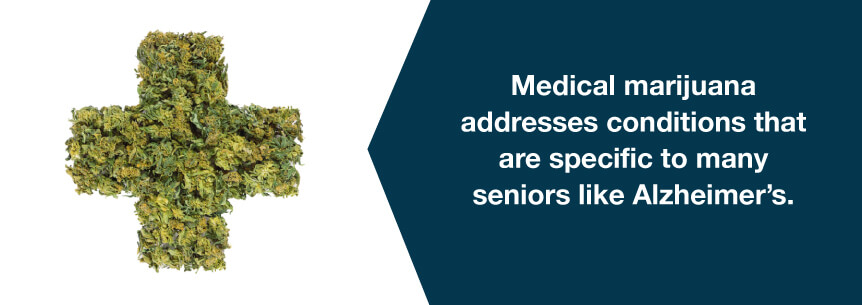
Patients can use cannabis as a supplement to their prescription drugs or even as a total replacement. Cannabis medicine can enhance the efficiency of some drugs, letting you lower your dosage and experience fewer side effects. In some cases, patients find they can go completely off their prescription medication. Of course, before you make a decision regarding any kind of medicine, consult your doctor first.
According to a Harvard study, 85% of Americans support the cause of using cannabis for medical marijuana needs. This represents over half the population speaking out for the medicinal drug’s use, which may be why 29 out of the 50 states have made medical marijuana legal.
While medical marijuana is not legal at the a federal level, the FDA did approve two strands of cannabinoids as medication for cancer patients. Both of them are synthetic marijuana, used to treat the nausea in cancer patients. They can be taken orally by a pill.
The Harvard article continues to say that cannabis is becoming more of an attractive option to not only seniors but also others who suffer from chronic illness, as it is impossible to overdose and does not leave lasting effects on the individual the way prescription drugs do. This makes it a safe alternative to prescription drugs, in more ways than one, allowing the patient to take the natural route to pain relief.
One of the main arguments of opponents of medical cannabis is that if the federal government has not legalized marijuana as a medication, it can’t be safe. This disregards the fact that 29 out of 50 states have already legalized medical marijuana.
We must listen to the patients. The federal government has yet to legalize medical cannabis because of the lack of clinical studies. Seniors interested in pushing for the legalization of medical marijuana may want to consider taking part in studies in order to show how vital this medicine can be for the elderly.
Cannabis has been around for thousands of years, as it is a natural plant, and studies among seniors, in particular, have shown it to demonstrate extensive improvements in their conditions. It even presents an easy alternative to taking medications such as aspirin or ibuprofen to manage chronic pain, opening new doors for seniors who would prefer to keep their dependence on pills to a minimum.
Here are a few statistics about medical cannabis use in senior citizens:
Also, from the span of 2006 to 2013, the usage of medical marijuana amongst seniors increased by 250 percent. And that number continues to grow. The American Association of Retired Persons, also known as AARP, has taken a strong pro stance on the legalization of medical marijuana for the past decade. Seniors of the baby boomer generation are even starting to plan their retirement in states where medical marijuana is legal.
Some seniors may worry about how they will get access to medical marijuana if they go to a retirement home. When it comes to retirement homes and nursing centers for seniors in states with legal marijuana usage, if residents have a prescription, they can use medical marijuana and have it distributed as part of their medications. Even in nursing homes that prohibit smoking, there are many alternatives, such as vaping or edibles, that can be used in order for a resident to receive their medication.
The benefits of using medical marijuana in a retirement home extend to many different facets of life. For instance, in a nursing home, cannabis can be:
There is even the new development of “pot parties” throughout retirement communities. Similar to what they would do at a Tupperware party, the host offers up an educational experience on how the different strains of marijuana work and how it can be effective for each individual. If a person is unable to smoke, these parties offer more varieties of marijuana intake, such as bath soaks, edibles and capsules.
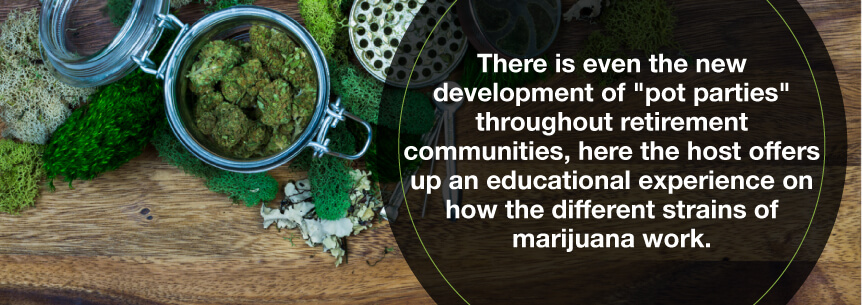
Not only are these pot parties a good educational experience, but they encourage the community aspect and socialization many seniors enjoy and benefit from. It is a way for those who are hesitant about using medical marijuana to feel more comfortable to learn about the potential and benefits cannabis offer for the senior population.
Not all seniors live in a nursing home, of course, but even if you remain at home or live with a family member, you may have limited mobility. Some seniors choose not to drive or only drive at certain times of the day. Others rely on their children or grandchildren to get them around town, and you may find it is hard to add another stop for picking up your medical marijuana on such trips. Here are a few other ways you can receive your prescribed marijuana medicine:
Finding low-stress ways to get your medicine will put your mind at ease. Asking others you know who employ medical cannabis for their medical conditions about their delivery methods may also open up new pathways to getting your medicine to your home.
Do you want to find out if medical marijuana will work as the solution to your health problems? Getting started involves a few easy steps:
Medical marijuana could be a natural scientific breakthrough for many adults, especially seniors, who suffer from severe and chronic illnesses. There are many sources to find out more about medical marijuana and the advantages it can provide you, and those resources start with us. From finding doctors to researching state law and qualifications to finding new discoveries about this form of medication, Marijuana Doctors can help you.
No Information on MarijuanaDoctors.Com should be used to diagnose, treat, prevent or cure any disease or condition. You can view our Full Disclaimer here.